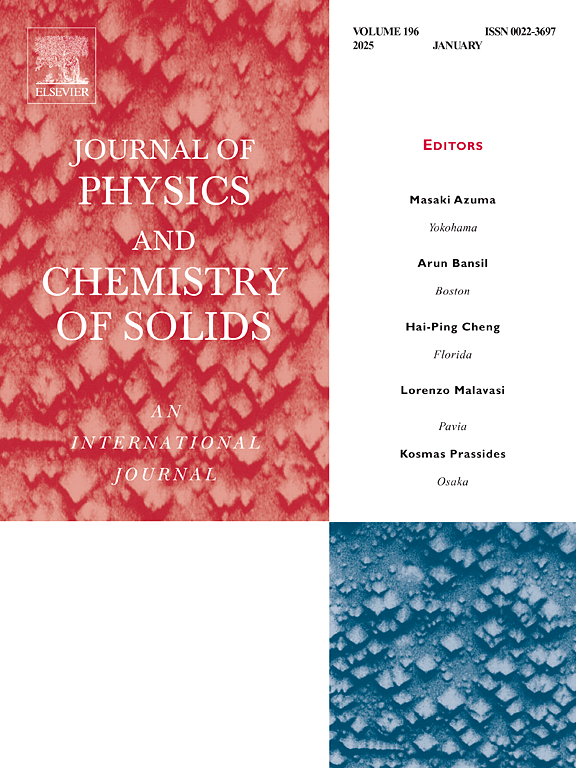揭示SrTiO3: TiSr反位缺陷中的隐藏电荷陷阱
IF 4.3
3区 材料科学
Q2 CHEMISTRY, MULTIDISCIPLINARY
引用次数: 0
摘要
在基于氧化物的电子系统中,极性点缺陷作为电荷陷阱,强烈影响这些系统的电学性能。虽然阳离子反位缺陷通常存在于氧化物中,并引起了诸如铁电性、自旋有序和阴极发光等有趣的物理现象,但它们的基本电荷捕获特性仍然难以捉摸。在此,我们证明了反位Ti缺陷(TiSr)可以作为SrTiO3 (STO)中重要的电荷陷阱。通过调整STO的阳离子化学计量,可以精确控制TiSr缺陷的形成,并通过低温光致发光和拉曼光谱进行了验证。然后,通过在化学计量控制的STO上原位生长的超薄SrRuO3 (SRO)通道的低频噪声测量,直接检测了TiSr缺陷的电荷捕获。具有较高TiSr缺陷密度的STO薄膜上的SRO通道表现出两种洛伦兹噪声分量的独特特征,而化学计量STO上的SRO通道表现出典型的1/f型噪声。我们对热激活过程的分析表明,由于界面带位移,TiSr缺陷引起的电荷捕获可以在相当低的活化能(~ 0.044 eV)下发生。这些结果表明,以前被低估的与阳离子相关的点缺陷可以显著影响氧化物基电子系统的电子性能。本文章由计算机程序翻译,如有差异,请以英文原文为准。
Unveiling hidden charge traps in SrTiO3: TiSr antisite defects
In oxide-based electronic systems, polar point defects act as charge traps and strongly influence the electrical properties of these systems. While cation antisite defects are commonly present in oxides and give rise to intriguing physical phenomena such as ferroelectricity, spin ordering, and cathodoluminescence, their fundamental charge trapping characteristics remain elusive. Herein, we demonstrate that antisite Ti defects (TiSr) can serve as significant charge traps in SrTiO3 (STO). The formation of TiSr defects was precisely controlled by adjusting the cation stoichiometry of STO, as verified by low-temperature photoluminescence and Raman spectroscopy. The charge trapping of TiSr defects was then directly examined through low-frequency noise measurements of ultrathin SrRuO3 (SRO) channels, which were in-situ grown on the stoichiometry-controlled STO. The SRO channel on STO films with a higher density of TiSr defects shows a unique feature of two Lorentzian noise components, while that on stoichiometric STO exhibits a typical 1/f-type noise. Our analysis of the thermal activation process reveals that TiSr defect-induced charge trapping can occur with a quite low activation energy of ∼0.044 eV due to interfacial band shift. These results suggest that cation-related point defects, which have previously been underestimated, can significantly impact the electronic properties of oxide-based electronic systems.
求助全文
通过发布文献求助,成功后即可免费获取论文全文。
去求助
来源期刊
CiteScore
7.80
自引率
2.50%
发文量
605
审稿时长
40 days
期刊介绍:
The Journal of Physics and Chemistry of Solids is a well-established international medium for publication of archival research in condensed matter and materials sciences. Areas of interest broadly include experimental and theoretical research on electronic, magnetic, spectroscopic and structural properties as well as the statistical mechanics and thermodynamics of materials. The focus is on gaining physical and chemical insight into the properties and potential applications of condensed matter systems.
Within the broad scope of the journal, beyond regular contributions, the editors have identified submissions in the following areas of physics and chemistry of solids to be of special current interest to the journal:
Low-dimensional systems
Exotic states of quantum electron matter including topological phases
Energy conversion and storage
Interfaces, nanoparticles and catalysts.

 求助内容:
求助内容: 应助结果提醒方式:
应助结果提醒方式:


